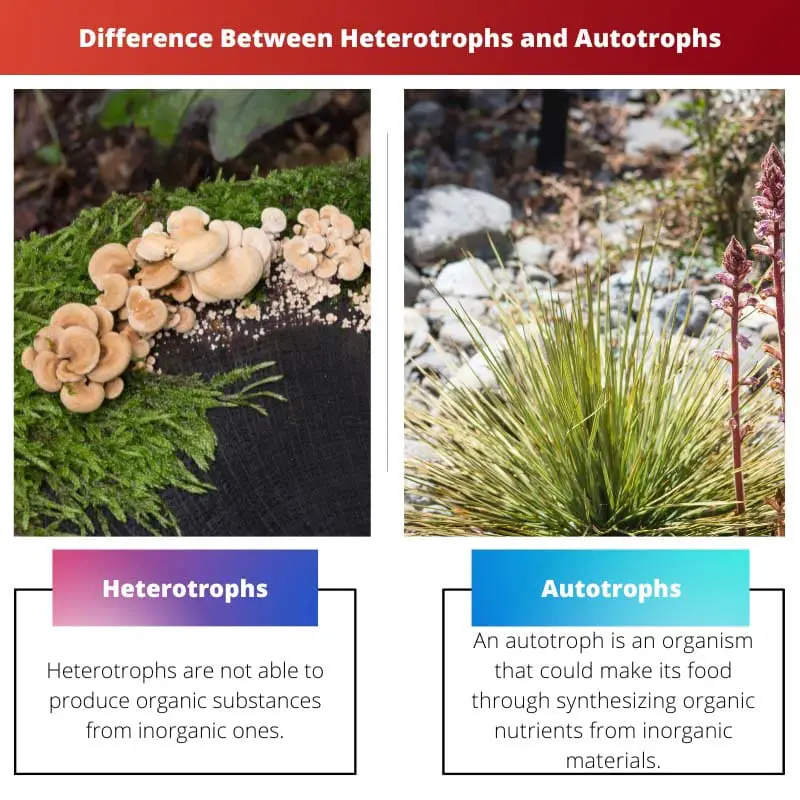Both these play an important role in the food chain and are interconnected to one another.
Heterotrophs are creatures that do not have the ability to make their own food and rely on other species for their nourishment, whereas organisms that can make their food through sunlight and water are called autotrophs.
Key Takeaways
- Heterotrophs are organisms that obtain their energy and nutrients by consuming other organisms, as they cannot produce food.
- Autotrophs are organisms capable of producing food through photosynthesis or chemosynthesis, using energy from sunlight or inorganic chemical reactions.
- Both heterotrophs and autotrophs are essential components of ecosystems, but heterotrophs rely on consuming other organisms for energy, while autotrophs generate their energy from external sources.
Heterotrophs vs Autotrophs
The difference between Heterotrophs and Autotrophs is that heterotrophs cannot make their food, so they have to consume or absorb it. On the other hand, autotrophs are organisms that prepare their nourishment via photosynthesis. Therefore, autotrophs are producers, and heterotrophs are consumers.

Heterotrophs are not able to produce organic substances from inorganic ones. Heterotrophs rely both directly or indirectly on autotrophs for vitamins and food energy.
For example, raccoons could eat corn (maize) planted in a field or seize and consume rodents that depend upon corn as a food source.
An autotroph is an organism that can make its food by synthesizing organic nutrients from inorganic materials, the use of power from daylight or a chemical source to power the process.
The autotrophic lifestyle is exemplified by plants, which Utilize solar energy to convert carbon dioxide and water into the naturally occurring molecule glucose, which is produced via photosynthesis.
Comparison Table
| Parameters of Comparison | Heterotrophs | Autotrophs |
|---|---|---|
| Raw material | No raw material is needed. | Raw materials are required. |
| Level in the food chain | They are at a secondary level in the food chain. | These are at the primary level. |
| Digestion | Digestion is required to convert complex substances into simpler ones. | No need for digestion. |
| Food making | Food can be prepared at any time. | Food is prepared only in the daytime. |
| Examples | Herbivores, carnivores | Plants, algae |
What are Heterotrophs?
A heterotroph is an organism that obtains energy and sustenance through the consumption of other plants or animals. The period originates from the Greek terms hetero for “different” and trophy for “nourishment.”
Heterotrophs are termed consumers owing to the fact they devour producers or various consumers.
Dogs, birds, fish, and humans are all heterotrophs. Heterotrophs occupy the second and third tiers of a food chain, a sequence of creatures that give electricity and vitamins to various species. Each food chain has 3 trophic levels, which characterize an organism’s role in an ecosystem.
Occupying the main trophic level are autotrophs, including plants and algae. Herbivores are creatures that devour flowers at the second level. Carnivores are creatures that devour meat, and omnivores are species that ingest flowers and meat and occupy the third level.
Both main (herbivores) and secondary (carnivores and omnivores) consumers are heterotrophs and, simultaneously, as number one producers, autotrophs. The third sort of heterotrophic consumer is a detritivore.
These creatures gain meals via feeding on the remnants of plant life and animals in addition to waste materials. Detritivores serve a significant part in sustaining a healthy environment via recycling garbage.
What are Autotrophs?
An autotroph is a creature that might manufacture its nourishment utilizing light, water, carbon dioxide, or alternative substances. Because autotrophs make their food, they’re frequently regarded as producers.
Plants are the most recognizable sort of autotroph, although there are other distinct kinds of autotrophic creatures. Algae, which remains in the water and whose giant forms are termed seaweed, are autotrophic.
Phytoplankton, small creatures that reside withinside the water, are autotrophs. Some species of bacteria are autotrophs. Most autotrophs employ a method known as photosynthesis to create their food.
In photosynthesis, autotrophs utilize energy from the sun to turn water from the soil and carbon dioxide from the air straight into nutrition, known as glucose. Glucose is a form of sugar.
The glucose provides plants energy. Plants also utilize glucose to generate cellulose, a material they employ to build and construct cell walls. Some uncommon autotrophs create meals by a mechanism known as chemosynthesis, in preference to utilizing photosynthesis.
Autotrophs that carry out chemosynthesis do now no longer utilize energy from the sun to create nourishment. Instead, they make meals using energy from chemical reactions, frequently combining hydrogen sulfide or methane with oxygen. Autotrophic bacteria that produce meals via chemosynthesis have also been observed at seafloor regions known as cold seeps.
Main Difference Between Heterotrophs and Autotrophs
- Heterotrophs do not have chloroplasts, and so are unable to manufacture food. Autotrophs, on the other hand, use chloroplasts to aid in the preparation of their meal.
- Heterotrophs get energy from diverse species directly or indirectly, while autotrophs absorb energy from inorganic sources and transform it into chemical energy.
- It is possible for heterotrophs to travel between locations in quest of food and refuge. On the other hand, autotrophs can not move from their region.
- Heterotrophs include all members of the animal kingdom, while autotrophs include members of the plant kingdom as well as some unicellular organisms such as cyanobacteria.
- Heterotrophs use oxygen and release carbon dioxide withinside the environment. On the alternative side, autotrophs use carbon dioxide and release oxygen withinside the environment.




